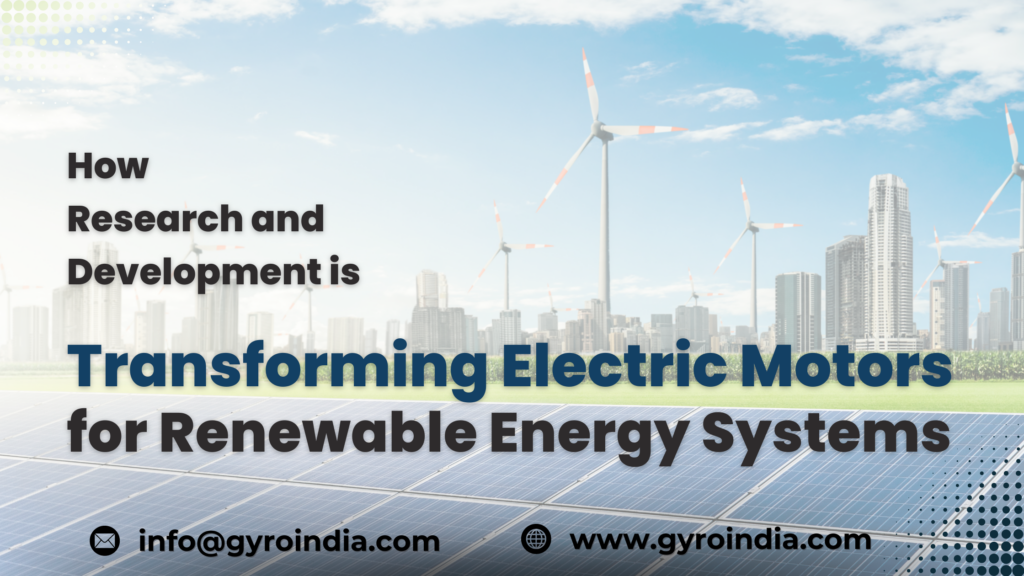How Research and Development is Transforming Electric Motors for Renewable Energy Systems
 Electric motors are increasingly essential in renewable energy systems, improving efficiency, reliability, and sustainability across various applications. Through research and development, these motors enhance the performance of wind turbines and solar tracking systems, driving ongoing advancements in the renewable energy sector.
Electric motors are increasingly essential in renewable energy systems, improving efficiency, reliability, and sustainability across various applications. Through research and development, these motors enhance the performance of wind turbines and solar tracking systems, driving ongoing advancements in the renewable energy sector.
How Electric Motors Power Renewable Energy Systems
Electric motors play a pivotal role in ensuring renewable energy systems operate efficiently. For instance, in wind turbines, they adjust blade angles to capture the maximum energy from fluctuating wind speeds. Meanwhile, in solar energy systems, motors move panels throughout the day, enabling them to follow the sun and therefore absorb optimal energy.
Additionally, hydroelectric plants benefit from electric motors, which drive turbines that convert water flow into electricity. As a result of these innovations, energy loss is minimized, significantly improving the overall performance of renewable energy systems.
What’s more, motors like Switched Reluctance Motors (SRMs) and Brushless DC (BLDC) motors are especially efficient. Their robust and durable designs make them ideal for renewable energy applications—whether large or small. These motors offer unmatched reliability across various conditions, reducing downtime and thus increasing overall system uptime.
Research and Development: Driving Motor Innovation
Ongoing research and development (R&D) is critical in advancing electric motor technology for renewable energy applications. Without these efforts, electric motors used in wind, solar, and hydro systems would not have reached their current levels of efficiency.
For instance, magnet-free motor designs have emerged through R&D, reducing the reliance on rare-earth materials, which in turn helps lower production costs and environmental impacts. Moreover, innovations in motor control systems now allow for precise energy management, significantly enhancing renewable energy reliability.
Furthermore, the integration of IoT technology has revolutionized electric motor performance. IoT connectivity enables real-time monitoring and adjustments, thereby optimizing energy output and pushing renewable energy efficiency to new heights.
Electric Motors and Sustainability
Electric motors undeniably contribute to sustainability in renewable energy systems by reducing both energy consumption and carbon emissions. Compared to traditional motors, SRM motors consume up to 50% less power, thereby significantly reducing energy usage.
Moreover, sustainability initiatives focus on the materials used in motor production. Specifically, magnet-free motors lower the reliance on rare-earth elements, minimizing the environmental damage caused by mining. Additionally, modern electric motors are designed with recyclability in mind, contributing to a circular economy and further promoting sustainability.
Addressing Challenges in Renewable Energy
Despite their benefits, renewable energy systems face challenges such as high maintenance costs and performance reliability. However, electric motors are well-equipped to address these issues with designs that offer low maintenance, rugged durability, and superior efficiency. SRMs, in particular, are known for their robust performance and ability to handle demanding conditions.
In addition, IoT-enabled motors come with predictive maintenance capabilities, allowing real-time monitoring that helps prevent failures before they occur. This not only reduces operational costs but also improves overall system reliability. Thus, IoT technology ensures smooth operation of renewable energy systems, making them more resilient and cost-effective over time.
Conclusion
Electric motors are undoubtedly critical to the success of renewable energy systems, driving improvements in efficiency, sustainability, and cost-effectiveness. With continuous research and development, new advancements in magnet-free designs and IoT integration are unlocking further potential in electric motors, making renewable energy systems more reliable and efficient. Ultimately, by reducing energy consumption and carbon footprints, electric motors are transforming the renewable energy landscape.

Leave a Reply